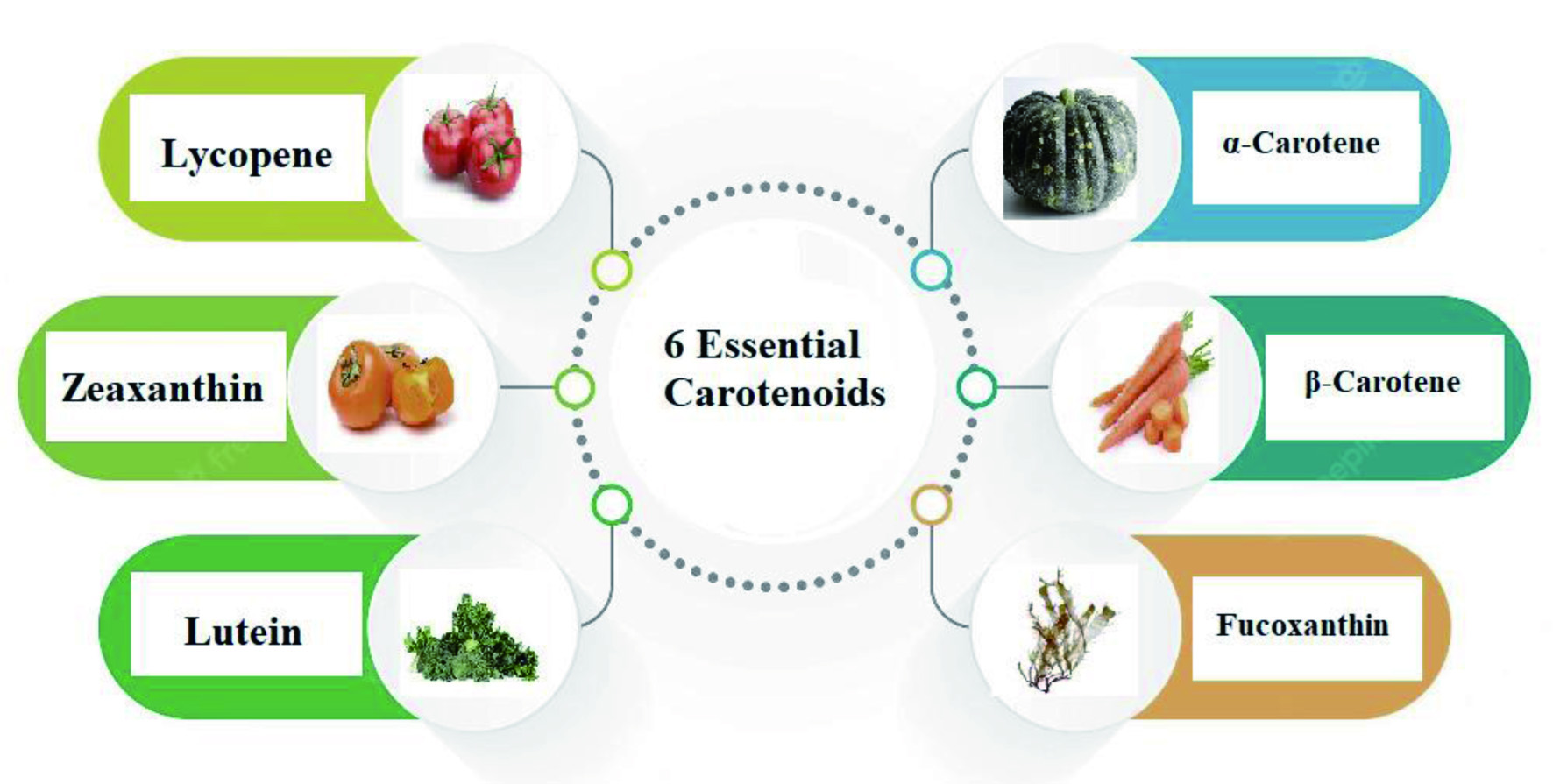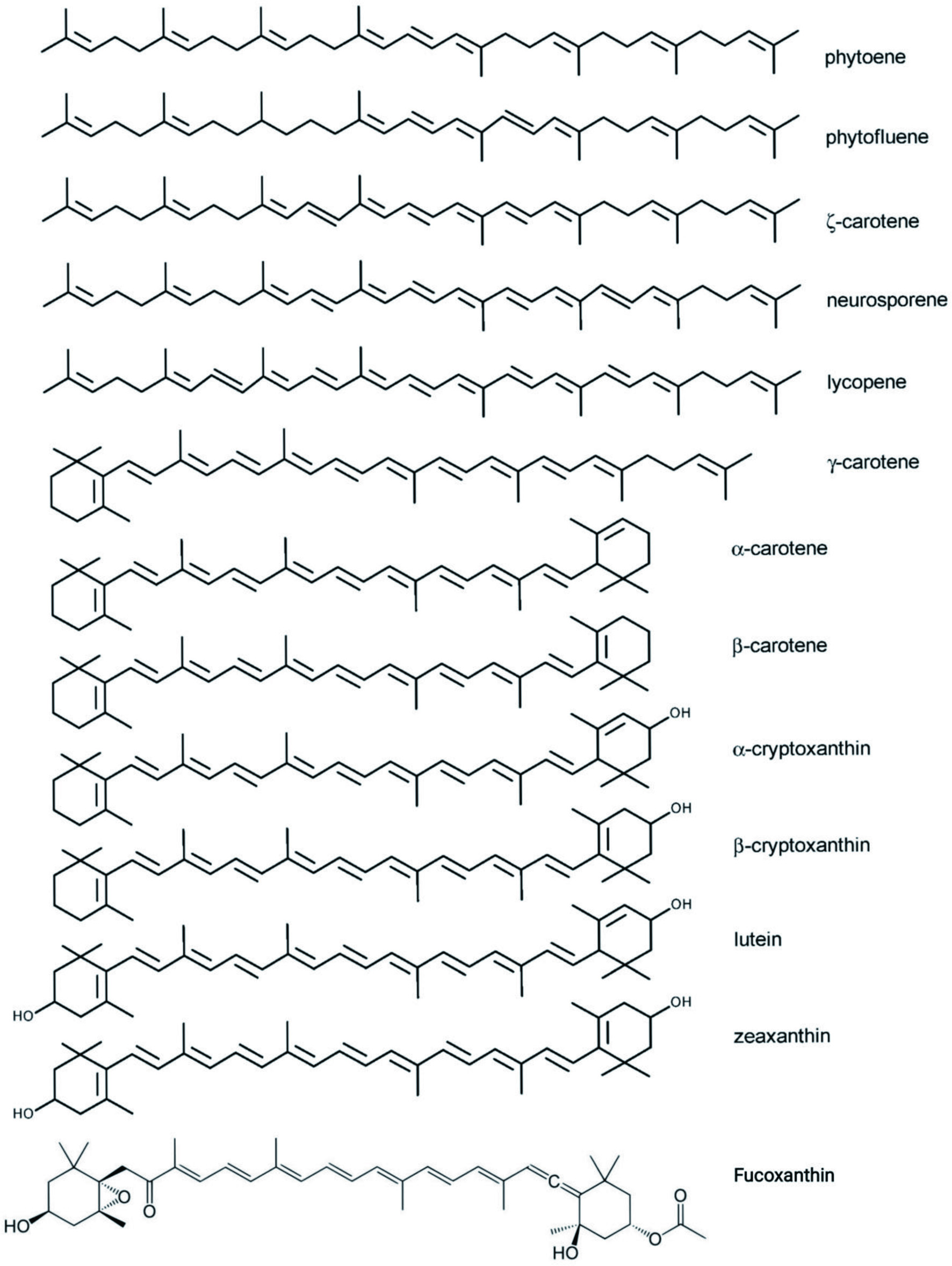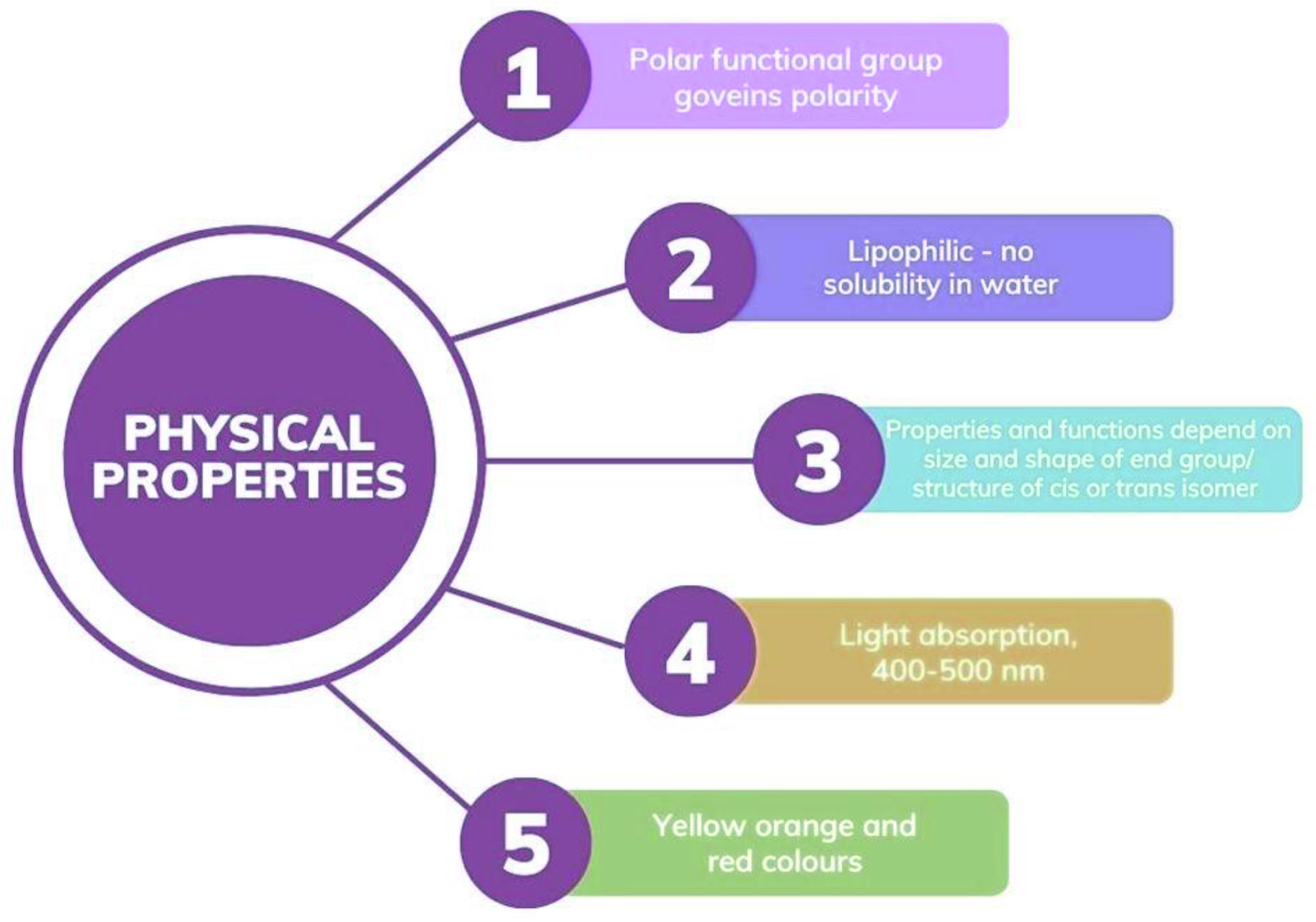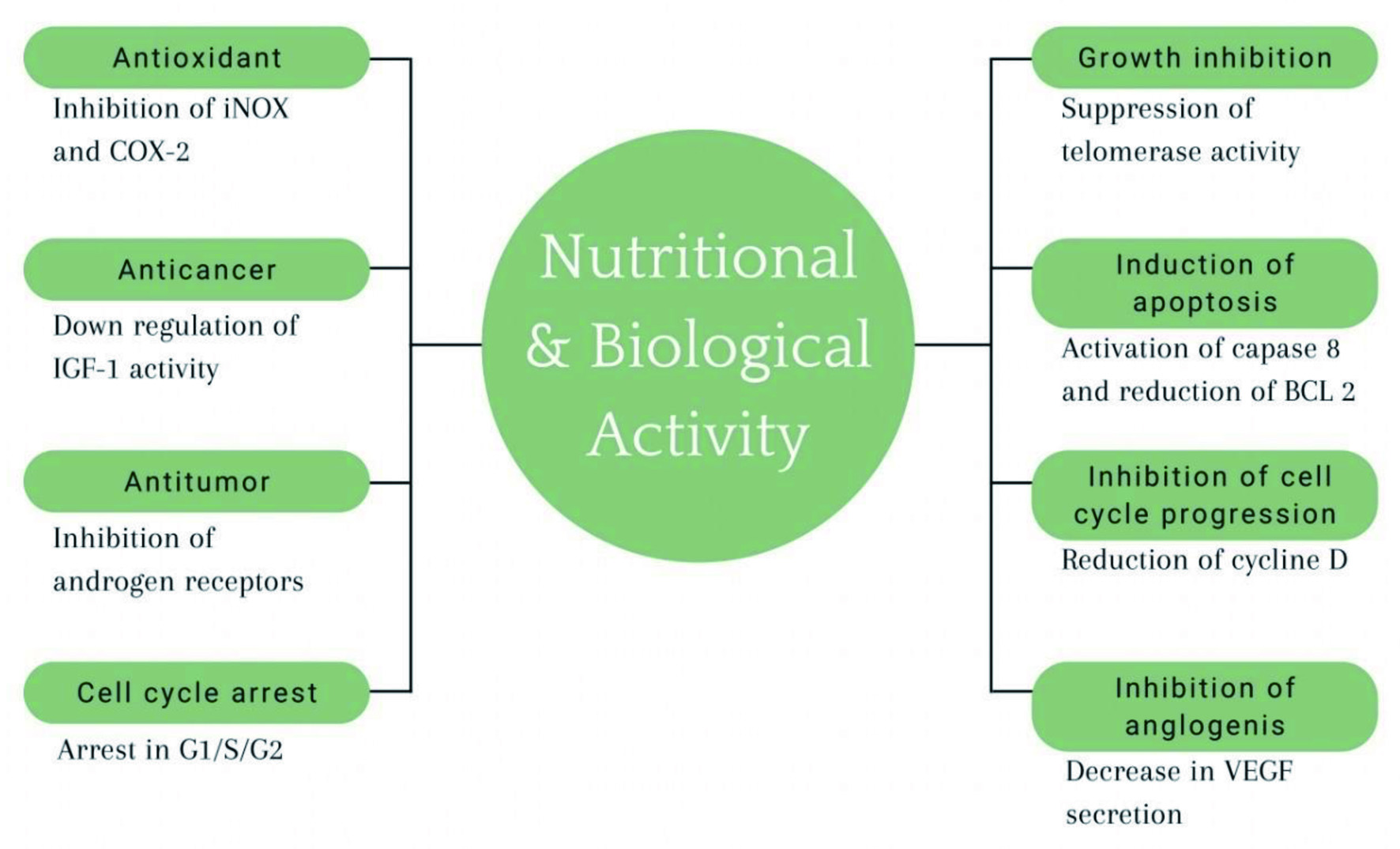
Figure 1. Essential carotenoids and sources.
| Journal of Food Bioactives, ISSN 2637-8752 print, 2637-8779 online |
| Journal website www.isnff-jfb.com |
Review
Volume 21, March 2023, pages 3-20
Uses of carotenoid-rich ingredients to design functional foods: a review
Figures




Tables
| Sample | Analyte | Analytical technique | References |
|---|---|---|---|
| ACN: Acetonitrile; APO: Trans-b-apo-80-carotenal; BHT: Butylhydroxytoluene; DCM: Dichloromethane; MeOH: Methanol; MTBE: Methyl tert-butyl ether; THF: Tetrahydrofuran; SFC: Supercritical fluid chromatography; RP: Reversed phase; HPTLC: High-performance thin-layer chromatography; UPLC: Ultra-high-performance liquid chromatography. | |||
| Tamarillo (Solanum betaceum Cav.) | Zeaxanthin; Lutein; Apocarotenal; Physalins; β-Carotene; β-Cryptoxanthin | LE and LC-PDA-MS analysis, C30 column (250 × 4.6 mm, 5 µL), mobile phase: (A) water/20 mm ammonium acetate, (B) MeOH/20 mm ammonium acetate and (C) MTBE gradient elution | Giuffrida et al., 2018 |
| Tomatoes | Lycopene; Lutein; β-Carotene; α-Tocopherol | LC-UV/VIS: RP C18 column (125× 4.6 mm, 5 µm), mobile phase (MeOH:ACN:DCM, 50:48:2 v/v/v) | Zanfini et al., 2010 |
| Carrot | β-Carotene; Carotenes; Xantophylls | LC-PDA: RP C18 column (250 mm), mobile phase (A): MeOH and (C) 10% n-hexane with ACN, (B) 1% water in MeOH | Agócs et al., 2007 |
| Different citrus species (lime, mandarin, orange, clementine, grapefruit, lemon and kumquat) | β-Carotene; α-Carotene; β-Citraurin; Lutein Violaxanthin; (9z)-violaxanthin; Mutatoxanthin; β-cryptoxanthin; zeaxanthin | LC-PDA: C18 column (250× 4.6 mm, 5 µm), mobile phase (A): 30 percent (v/v) DCM in MeOH, (B): MeOH, (C): MeOH containing 12% (v/v) H2O | Kidmose et al., 2007 |
| Sweet potato | β-Carotene and isomers | LC-PDA: C30 column (250 ×4.6 mm, 5 µm), isocratic elution, mobile phase: MeOH/MTBE (80:20 v/v) | Sancho et al., 2011 |
| Coriander (Coriandrim sativum L) | β-Carotene | LC-PDA: RP C18 column (259×4.6 mm), mobile phase: ACN:MeOH:Ethylacetate (80:10:10 v/v/v) | Divya et al., 2012 |
| Papaya | β-Carotene; β-Cryptoxanthin; Lycopene | LC-PDA-APCI (+)/MS: C30 column (150 mm × 4.6 mm, 3 µm), mobile phase: (A) MTBE (B) MeOH: gradient elution 0 to 100% | Divya et al., 2012 |
| Orange juice | Lutein; Zeaxanthin; β-cryptoxanthin; α -cryptoxanthin β-carotene; α-carotene | LC-PDA: RP C18 column (250×4.6 mm, 5 µm), mobile phase: (A) ACN/DCM/MeOH 70:5:25 (v/v/v), (B) MeOH/water 75:25 v/v | Ndolo and Beta, 2013 |
| Cereal grains | 13-cis lutein; 9-cis lutein; 90-cis lutein; Zeaxanthin; β-cryptoxanthin; Lutein | LC-PDA: S-3 column (4.6 ×100 mm, 3 µm), mobile phase: MeOH/MTBE/Milli Q water (81:15:4, v/v/v) and MeOH/MTBE (90:19, v/v) | Ndolo and Beta, 2013 |
| Saffron | Trans and cis-isomers of crocin | LC-PDA-ESI (+)/MS: SB-C18 column (4.6×150 mm, 3.5 µm) linked to an SB-C18 guard column, mobile phase: (A) 0.15% formic acid in MeOH, and (B) 0.15% formic acid in water | Lech et al., 2009 |
| Frozen carrot and spinach | Lutein Phytofluene Phytoene; β-Carotene; α-Carotene | LC-PDA: Column ODS3 (250×4.6 mm 5 µm), mobile phase: (A) ACN/n-hexane/MeOH and DCM (2:1:1:1, v/v/v/v), and (B) ACN | Mazzeo et al., 2011 |
| Product | Sources of Carotenoids | Carotenoids | Treatment | Product properties | Ref. |
|---|---|---|---|---|---|
| Rice muffins | Shiitake mushroom & carrot pomace | – | Incorporation of CP & MP at 5, 10, and 15% into 200 g of rice flour | The enriched muffins with 5 and 10% had better consumer acceptability and higher antioxidant capacity | Olawuyi and Lee, 2019 |
| Bread & cake | Passion fruit peel | lutein, zeaxanthin, α-carotene, β-carotene, provitamin A | Enriched bread and cake were prepared with 85:15 (wheat flour:OP) and 50:50 (wheat flour:OP) | The fortified product had about 80% acceptance score with strong antioxidant activity | Reis et al., 2020 |
| Bread | Orange-fleshed sweet potato puree | β-carotene | Enriched bread constituted of 30% puree and 70% wheat flour | The formulated cake had longer shelf life and reduced water activity | Wanjuu et al., 2018 |
| Bread and muffin | Hairless canary seed & corn | lutein, zeaxanthin, β-cryptoxanthin | HCS with corn flour at ratios of 1:1 and 1:2 (w/w) | The higher reduction of total carotenoids under dough process | Abdel-Aal, 2008 |
| Bread | Stinging nettle | lutein & carotene | The incorporation of 100 g nettle leaves with 1 kg of double zero flour, 500 mL water; 40 g extra-virgin olive oil, 30 g yeast, 20 g NaCl, and 10 g enzyme | The formulated bread possessed higher antioxidant activities and contained higher mineral compounds, fibers, and antioxidant compounds | Maietti et al., 2021 |
| Bread | Orange-fleshed sweet potato | all-trans β-carotene | The formulated bread contained 10:90, 20:80, and 30:70 w/w (OFSP: wheat flours), 3% sugar, 1% salt, 1% fat, 2% yeast, and 1% EN85 | The formulated could supply vitamin A deficiency in children | Nzamwita et al., 2017 |
| Cake &cookies | Tomato waste | lycopene | The cakes were made from 1–5% lycopene extracts, 500 g wheat flour (72%), 60 ml sunflower oil, 320 ml cow milk 3.5% fat, 2 eggs, 300 g sugar, 2 g vanillin, 16 g baking powder, and 4 g coconut powder and the cookies had 500 g wheat flour (72%), 750 g butter (80% fat), 2 eggs, 150 g powdered sugar, 1 g vanillin and 8 g baking powder in addition to lycopene | No significant changes in the color and sensory attributes of lycopene-enriched cakes and cookies and a significant increasing in their antioxidant activities | Eletr et al., 2017 |
| Bread | Yellow sweet potato | β-carotene | The enriched bread was made of 3–9% yellow sweet potato with 91–97% wheat flour | Increase β-carotene intake, moisture content, water activity and more yellowish color of bread with the increase of carotenoids | Nogueira et al., 2018 |
| Product | Carotenoid source | Treatment | Product properties | Ref. |
|---|---|---|---|---|
| Bread | Microalga: Chlorella sorokiniana | The gluten-free bread was enriched with 2.5 g (M2.5) or 5.0 g (M5.0) of microalga powder per 100 g of the blend of rice flour and corn starch in substitution of pea flour. | By increasing the microalga powder, protein content and carotenoids content were increased | Diprat et al., 2020 |
| Bread | Bee pollen | The effect of bee pollen at 1, 2, 3, 4, and 5% levels were evaluated the aroma, nutritional, and bioactive ingredients of technologically viable gluten-free bread | The proteins, minerals, soluble and bioaccessible polyphenols, antiradical activity, and total carotenoids were increased at almost all levels (2–5%) | Conte et al., 2020 |
| Bread | Microalga: Tetraselmis chuii, Chlorella vulgaris, and Nannochloropsis gaditana | 4% (w/w, total flour basis) microalgae were added to formulations based on Buckwheat flour Provida (46%) and Rice flour Espiga (31%) | Significant increase in lipids, proteins, antioxidant activity, minerals (Ca, K, Mg, P, Fe, S, Zn, Cu, Mn), and total phenol components was observed to increase different species of microalgae | Qazi et al., 2022 |
| Crackers | Cactus (Opuntia monacantha) | The effect of adding cactus mucilage (2%) and cladode flour (5, 10, 15%) on gluten-free cracker based on sour cassava starch (60%), wholegrain buckwheat flour (10%), and rice flour (30%) | In comparison with control sample, physical properties were not impacted (except for the darker color), higher total phenolic and antioxidant activity, and carotenoids were observed | Dick et al., 2020 |
| Fresh pasta | Arthrospira platensis (spirulina) | The effect of Arthrospira platensis (dried in different temperatures) replacement (1 to 15% w/w) with rice flour on physicochemical, sensory, and digestibility of gluten-free pasta based on rice flour and Psyllium gel in a 50/50 ratio was evaluated | Adding the A. platensis biomass leads to higher carotenoids, phenolic compounds, chlorophylls, and antioxidant activity in the gluten-free pastas, in comparison with control (without A. platensis) and wheat pasta | Fradinho et al., 2020 |
| Product | By-product | Experiment | Effect on Meat and/or meat product | Ref. |
|---|---|---|---|---|
| Beef muscle | Orange Peel Extract | Effect of 2, 4, and 4% of orange peel extract on fresh and preserved beef for 0, 15, 30, and 60 days of the storage period evaluated | Color, flavour, tenderness, juiciness, and overall acceptability at varied concentrations of orange peel extract were almost like control but decreased remarkably with increased storage time | Haque et al., 2020 |
| Alternatively cured all-pork Bologna sausage | Citrus fiber | Sodium tripolyphosphate replacement with citrus fiber (0.50, 0.75, and 1.00%) | Citrus fiber treatments resulted in bologna sausage with excellent technological properties, as indicated by similar emulsion stability and cook/chill yields | Powell et al., 2019 |
| Low-fat beef hamburgers | Lemon fiber | Evaluation of replacing fat with lemon fiber (2, 4, and 6% levels) on physico-chemical, organoleptic, and textural properties of low-fat beef hamburgers | lemon fiber increased cooking yield and moisture content due to its better water-binding characteristics, redder, lighter, and more yellow color; hardness, springiness, gumminess, and chewiness values decreased when the concentration of lemon fibers increased | Soncu et al., 2015 |
| Beef patties | Citrus orange or lemon peels powder | Quality properties and shelf-life evaluation of the beef patties during refrigeration storage at 4 ± 1 °C for 15 days by adding citrus peels | Thiobarbituric acid reactive (TBA) substances, microbial count, pH value, total volatile basic nitrogen, and shrinkage decreased; increase in cooking yield, water and oil holding capacity, and moisture and fat retentions by adding 1 or 2% of both powders. The color, texture and sensory properties, and radical scavenging activity affected in resulted of adding powders | Ibrahim et al., 2018 |
| Beef burger | Orange Peel Powder | Evaluated the lipid stability of beef burger with varied percentages (2.5, 5.0, 7.5, and 10.0%) of orange peel | The lowest TBA value was determined in the burger with 10% | Mahmoud et al., 2017 |
| Turkey sausage | Citrus paradisi fruit barks (CPFB) extract | Assessment of different solvents, including ethyl acetate, methanol and water on antimicrobial and antioxidant activities of CPFB extract and turkey sausage shelf life. | CPFB retard lipid oxidation in sausages was evaluated at the level of 2.5 g kg−1 turkey sausage, by the CPFB water extract addition, the number of microorganisms decreased significantly | Sayari et al., 2015 |
| Products | Sources of carotenoids | Types of carotenoids | Treatment | Outcomes | Ref. |
|---|---|---|---|---|---|
| Pasta | Gac fruit | lutein, β -carotene, zeaxanthin, β -cryptoxanthin, α-carotene, lycopene, and α-carotene | The incorporation of 5–15 g gac fruits powder, 85–95 g wheat flour, 1 g salt, 50 g whole egg, and 5 g vegetable oil | Significant increase dietary in fiber, hardness, cohesiveness and decrease in the total carotenoids during cooking and water absorption and swelling index | Chusak et al., 2020 |
| Dry pasta | Carrot flour | β -carotene, lutein, zeaxanthin, cryptoxanthin, α-carotene | From 10% to 20% carrot flour, 100% wheat flour, 37.5% egg powder and 1.13 and 1.35% commercial β-carotene, 25–50% water | Improvement of sensory and nutritional values, carotenoid levels, antioxidant capacity, total fibers, and color | Porto Dalla Costa et al., 2016 |
| Pasta | Urtica dioica L. | β-carotene & lutein | The mixture of 3.5% (w/w) dried nettle leaves, semolina and 20% (w/w) egg, 30% (w/w) water | The highest carotenoid content belonged to flowering stage of nettle which increased the formulated egg pasta and the highest bioaccessibility of nettle-based product at the early stage of colon fermentation | Marchetti et al., 2018 |
| Pasta | Tomato | lycopene & β-carotene | 10 and 15% (w/w) tomato peel flour, 2% hydrocolloids, water, and 85 and 90% (w/w) whole meal flour | The addition of tomato flour enhanced carotenoid and fiber contents but caused slight increase in cooking loss leading to make the pasta more adhesive and firmer with unpleasant odor | Padalino et al., 2017 |
| Pasta | Syzygium cumini L. pulp | β-carotene | The effects of from 0- 40% fruit pulp’s addition into pasta formulation on its antioxidant activities, functional compounds, and sensory attributes | It improved antioxidant capacity along with the improvement of nutritional components and caused an attractive appearance, but prolonged the cooking time | Panghal et al., 2018 |
| Spaghetti | Tomato peel | β-carotene, phytoene, phytofluene, cis-lycopene, lutein, cis-α-carotene, α-carotene, γ-carotene | The tomato-based spaghetti contained 72% extract wheat flour, 35% water and 1% salt 1%. | the enriched product had higher carotenoid contents and antioxidant capacity as well as higher consumer’s acceptability in terms of taste, color, and texture | Waqas et al., 2017 |
| Dried noodle | S. platensis | β-carotene | S. platensis powder and basil extract at 1:3 ratio, 200 g wheat flour, 30 g egg, 1 g salt, and 1 g baking powder | This incorporation increased protein, B-carotene and moisture contents and improved elasticity, and consumer acceptance of noodle | Agustini et al., 2017 |
| Soymilk mayonnaise | Sea buckthorn juice | - | Soy milk 30.8% (w/w), sunflower oil 61.5% (w/w), salt 1.5% (w/w), mustard 3.1% (w/w) and lemon juice 3.1% (w/w), and 3 and 6% (w/w) sea buckthorn juice | No significant decrease in all sensory attributes except color, inhibition of lipid peroxidation, peroxide value during eight weeks of storage | Nour, 2021 |